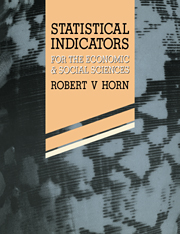Book contents
CHAPTER 3 - DEVELOPMENT APPLICATIONS OF INDICATORS
Published online by Cambridge University Press: 27 October 2009
Summary
Development—general
This book is concerned with indicators of the thrust, direction and impact of socioeconomic change, which can be identified with development. The term is often used as a synonym for growth or advancement, but it is useful to look at the distinction made by Daly and Cobb (1989: 71) between growth, seen as quantitative expansion in the scale of the physical dimensions of the economic system, and development, which should refer to the qualitative change of a physically non-growing economic system in dynamic disequilibrium with the environment.
Growth in that sense has natural limits, and it remains arguable whether such limits also apply to development as far as technology and social organisation are concerned. Both growth and development are forward looking; but as we approach the limits or potential of either, more attention is given to the reverse process of retrogression and ‘de-development’.
Economic, social and technological development can be broadly distinguished, but usually these aspects interact and should preferably be considered together. Social development cannot be separated from the economic limitations imposed by scarce resources; it is often expressed in terms of manpower, equipment or budgets. Social implications of the distribution of income and wealth, or of the impact on national welfare and the environment, are never far below the surface of economic analysis.
- Type
- Chapter
- Information
- Statistical IndicatorsFor the Economic and Social Sciences, pp. 67 - 101Publisher: Cambridge University PressPrint publication year: 1993



